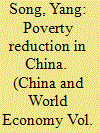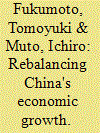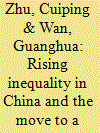|
|
|
Sort Order |
|
|
|
Items / Page
|
|
|
|
|
|
|
| Srl | Item |
| 1 |
ID:
111481


|
|
|
|
|
| Publication |
2012.
|
| Summary/Abstract |
This article seeks to develop a conceptual and policy framework for understanding China's role in the global economic imbalances. China's contribution to these imbalances via recurrent trade and financial surpluses corresponds with a phase of deepening structural risks to China's economic growth and development. These structural challenges include: the composition of growth resulting from China's dynamic internal transformation, China's trade orientation, the trajectory of resource use and CO2 emissions, welfare problems relating to distribution and international constraints. This article develops a conceptual framework for examining the relationship between the processes of long-run structural transformation in China, its economic imbalances, and the role of institutional reform in dealing with these structural challenges. As such, economic policy should extend beyond short-term macro management to pursue an institutional reform agenda to facilitate broader structural change to mitigate constraints to future growth and to improve economic welfare.
|
|
|
|
|
|
|
|
|
|
|
|
|
|
|
|
| 2 |
ID:
111482


|
|
|
|
|
| Publication |
2012.
|
| Summary/Abstract |
Economists have recently become interested in weighting how much domestic value-added is actually included in China's exports. Formally, the proportion of foreign and domestic contents could be identified by calculating the vertical specialization share using non-competitive input-output tables. Applying such a method to the Chinese case, however, would result in a big measurement bias because China has a large share of processing exports, which utilize a disproportionately high percentage of imported intermediates. This paper, by directly employing 2008 trade data for which imported intermediates in both processing and non-processing trade could be identified by means of various trade patterns, provides a simplified way to estimate the share of foreign/domestic value-added included in industry-level manufactured exports. This paper finds that the vertical specialization share of China's processing exports was about 56 percent in 2008, compared to about 10 percent for ordinary exports. It also finds that the sectors that experienced fast expansion of processing exports have a much higher share of foreign contents. Since processing exports account for about half of Chinese exports, the prevailing trade statistics, which focus on gross values rather than the value-added of exports and imports, has obviously overstated the bilateral trade imbalances, especially between China and the USA.
|
|
|
|
|
|
|
|
|
|
|
|
|
|
|
|
| 3 |
ID:
111483


|
|
|
|
|
| Publication |
2012.
|
| Summary/Abstract |
Through review of relevant studies and analysis, this article indicates that the "middle-income trap" is in line with the framework of the mainstream economic growth theories, and, therefore, it is a useful concept through which we can analyze economic growth phenomena in specific economic growth phases. The empirical experiences of many countries also indicate that at specific middle-income stages, economies with high rates of growth tend to encounter economic slowdown or even stagnation. The article shows that China is facing the challenge of determining how to move smoothly beyond the middle-income stage of economic development, while taking into account the shifting population structure, changing resource endowment and growth patterns. The article, drawing on international experiences, puts forward several policy suggestions relating to improvement in total factor productivity, expansion of human capital accumulation and deepening of system and government function reforms.
|
|
|
|
|
|
|
|
|
|
|
|
|
|
|
|
| 4 |
ID:
111486


|
|
|
|
|
| Publication |
2012.
|
| Summary/Abstract |
Using the instrumental variable model and the regression discontinuity approach, this paper explores how access to primary education affects the Chinese labor market and helps people to escape poverty. Several important findings are obtained. The popularization of primary education has significantly reduced poverty in China, especially in urban areas. In contrast, the Compulsory Education Law has not been well implemented for older children in rural areas. In addition, the labor market premium for completing primary education is much larger in urban areas than in rural areas. Poor rural school quality might explain this rural-urban disparity. Effort needs to be made to further reduce poverty by ensuring adequate financial resources for primary education in poor areas and improving school quality in rural China.
|
|
|
|
|
|
|
|
|
|
|
|
|
|
|
|
| 5 |
ID:
111484


|
|
|
|
|
| Publication |
2012.
|
| Summary/Abstract |
One of the greatest challenges China faces is reshaping its heavily investment-driven mode of economic growth. By investigating how the rebalancing of Japan's economic growth mode was realized in the 1970s, we indicate that it is essential in rebalancing to correct the distortions in factor cost (labor cost and capital cost) in a harmonious way. In addition, we refer to Japan's experience to indicate that rebalancing of domestic growth does not necessarily lead to external rebalancing.
|
|
|
|
|
|
|
|
|
|
|
|
|
|
|
|
| 6 |
ID:
111485


|
|
|
|
|
| Publication |
2012.
|
| Summary/Abstract |
China faces serious external (i.e. trade) and internal (i.e. structural) imbalances. Both are related to income inequality, reduction of which will help to increase domestic demand. This paper discusses how income inequality has evolved over time. This is followed by an exploration of the consequences of high inequality. Driving forces underlying the rising inequality are analyzed before providing concrete policy recommendations. It is found that inequality declined in the early period of reform, until the mid to late 1980s, and then began a rising trend up to 2010. Major determinants of inequality include: location, institutional and policy factors, trade and globalization, and education inequality and human capital gaps along rural-urban and spatial divisions. To achieve a balanced economy and a harmonious society, development policies in China must shift from emphasizing growth to prioritizing equality. In addition, government interventions can target rural-urban disparity through rapid urbanization, and tackle regional inequality by developing financial markets, ensuring progressive allocation of fiscal resources, promoting trade and foreign direct investment in inland China, creating more formal jobs and supporting the service sector.
|
|
|
|
|
|
|
|
|
|
|
|
|
|
|
|
|
|
|
|
|